Pioneering Treatment Saves Heart Tumour Husky
June 1, 2023
A Siberian Husky left fighting for life by a rare heart tumour has made a remarkable recovery after a year of pioneering treatment and specialist care at one of the UK’s elite animal hospitals.
Ten-year-old Dexter was in desperate danger, with local vets telling his devastated owners there was nothing they could do to save their treasured pet after being diagnosed with a tumour.
However, the family from Hornchurch, East London, refused to give up hope and sought a second opinion at Linnaeus-owned Southfields Veterinary Specialists in Basildon, Essex, which boasts world-leading care in radiation oncology and interventional radiology.
Southfields pledged to do all they could to save Dexter and a team of specialists combined their expertise and experience in a truly multidisciplinary approach to tackle the complex case and make good on that promise.
Internal medicine specialist, cardiology clinician and interventional radiologist Jon Wray said: “Dexter’s case is a great example of the high quality of the multidisciplinary care we offer at Southfields, including our world-leading interventional radiology treatment.
Jon is widely considered to have been at the vanguard in developing this pioneering treatment in the UK. Southfields is one of only three veterinary hospitals in England where radiation oncology and interventional radiology can be offered alongside each other – and, Jon believes, the only referral centre in the UK – where radiation oncology and interventional radiology can be offered alongside each other.
“That allowed us to successfully treat Dexter and all his complications from start to finish.”
The first task for Southfields’ specialist team, which also included renowned radiation oncology lead James Elliott, head of oncology Sarah Mason and cardiology specialist Xavier-Navarro-Cuba, was to target Dexter’s heart tumour.
James explained: “Dexter first came to us in March 2022 with heart failure caused by the large tumour arising from the base of his heart.
“Heart base tumours are unusual and it is rare for UK vets to have the expertise in radiotherapy to be able to offer this form of treatment.
“So, the good news was Dexter was in the right place. The even better news was his response to radiotherapy was incredible, with massive shrinkage of the tumour being achieved.”
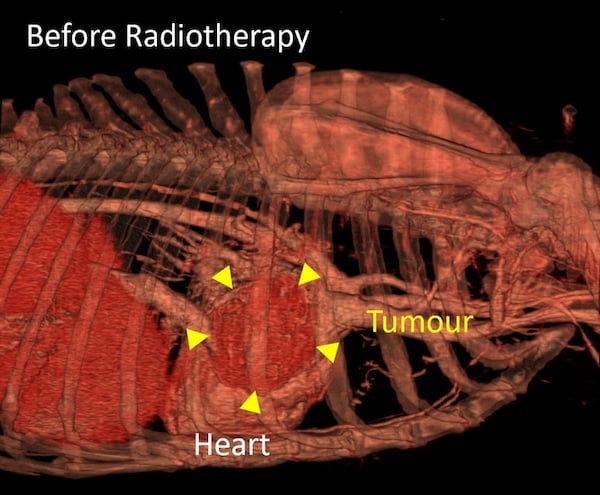
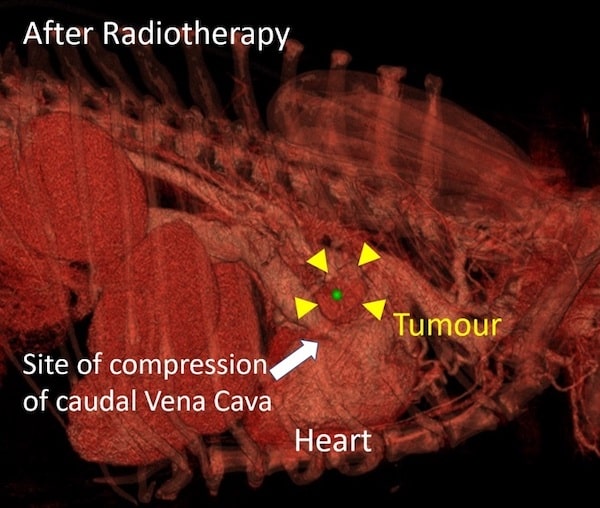
Before and after reconstructed CT scan series show the dramatic shrinkage of Dexter’s tumour following the pioneering treatment at Linnaeus-owned Southfields Veterinary Specialists in Basildon.
However, a few months later, Dexter developed a rare condition called Budd-Chiari Syndrome (BCS), where blood returning to the heart from the abdomen is blocked.
In Dexter’s case, the tumour was compressing a vital blood vessel and so much fluid was accumulating in his abdomen that it was preventing him from walking normally and was compressing the organs of his chest to limit his lung capacity.
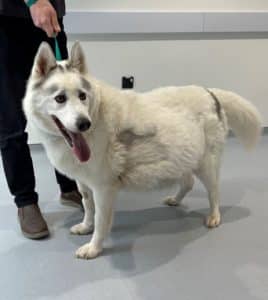
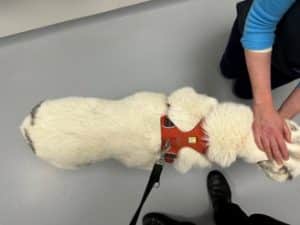
This presented a serious challenge for Dexter and the Southfields’ team, with Jon taking the lead to perform a ground-breaking procedure called trans-atrial stenting.
Jon, a leading exponent of the technique, added: “It is a rarely performed procedure and needs sophisticated planning and experience with vascular interventional radiology processes. It is a very challenging treatment to offer but ultimately a very successful one.
“The remarkable aspect is that I was able to perform the whole process without a single surgical incision or suture.
“That’s because the entire procedure was performed through not even a ‘keyhole’ incision but by puncturing a large vein with a needle and inserting an access sheath into it, through which I could ‘drive and navigate’ instruments into the heart.
Jon is one of a select few vets to have experience in previously treating Budd-Chiari Syndrome with this pioneering technique and said of it “there will be many vets in the UK who don’t realise that this is possible. It’s an excellent demonstration of what can now be achieved with Interventional Radiology techniques. It also showcases our expertise in radiation oncology, and our experience in interventional radiology which we can offer to the benefit of patients requiring this combined world-leading expertise.”
“It’s an excellent demonstration of what can now be achieved. It also showcases our expertise in radiation oncology and highlights that the interventional radiology we offer does not exist anywhere else in the UK.”
Jon described the materials technology behind the stent as a ‘medical marvel’. “These stents are woven from a single wire of a ‘memory alloy’ called NiTiNOL, which is a Nickel-Titanium structure. This alloy can be formed into a shape (in this case a tube) and retains the ‘memory’ to regain this shape when released. It is compressed within a thin delivery sheath that we can ‘drive’ into the heart through blood vessels and open the device to its original shape only when we are perfectly happy with its position. These materials have revolutionised our ability to provide solutions for previously seemingly insurmountable problems like Dexter’s”
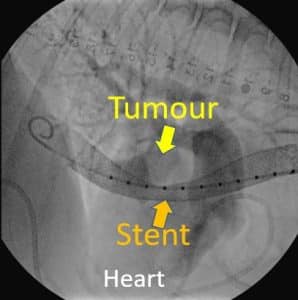
Dexter’s family are naturally delighted with the outcome and are in no doubt their beloved pet has only survived because of the skills and knowledge of the expert Southfields’ team.
The family said: “We had originally been told us there was nothing that could be done for Dexter.
“We were obviously heartbroken and devastated but we insisted on a second opinion from a specialist and we were referred to Southfields.
“James and Jon were honest and clear, and provided very detailed breakdowns of the procedures and what our various options were, including sketching out how things would work.
“James was incredibly patient in answering all our questions regarding radiotherapy and took great care in ensuring we understood the process.
“Jon was equally clear in breaking down the procedure for placing the stent. He drew diagrams to explain the technique and afterwards showed us actual photos and video of the stent being placed.
“So, throughout the year-long process we felt well informed and involved in the decisions being made.
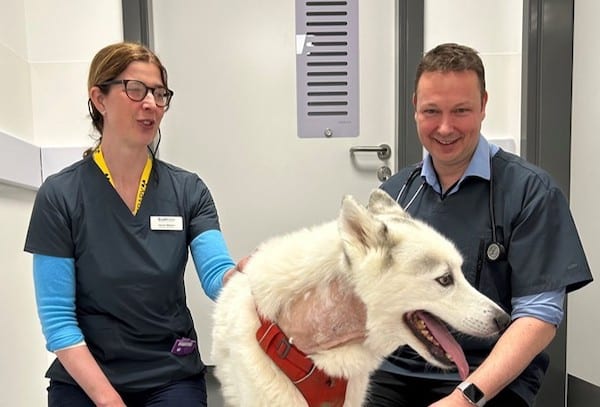
Dexter with Sarah Mason and Jon Wray at Southfields Veterinary Specialists in Basildon, Essex, after undergoing a ground-breaking procedure called trans-atrial stenting, a rare interventional technique.
“It was a tough time but we couldn’t have asked for a happier ending.
“After the stent was placed, it was as if the clock has been turned back. When we picked him up a couple of days after the procedure he was bouncing around and eager to come home.
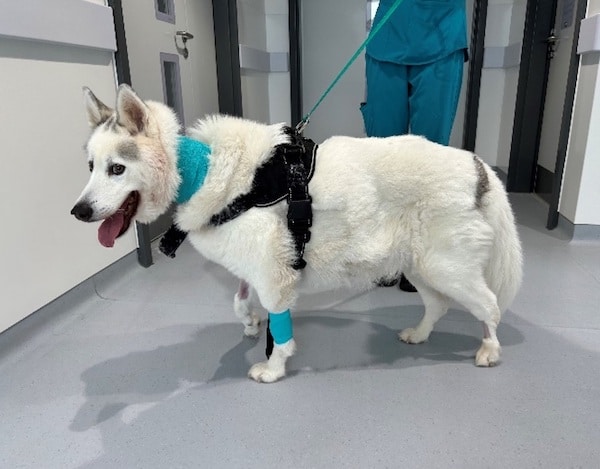
Dexter back on his feet just hours after undergoing a rare interventional technique at Southfields Veterinary Specialists in Basildon, Essex.
“His physical appearance had changed dramatically, too, as he’d had an incredible 26 litres of fluid drained from his stomach.
“Since Dexter has been home, he is continuing to go from strength to strength, wanting more exercise and to play with his friends again, so we’re very grateful and very pleased we asked Southfields for that second opinion!”

For more information about Cardiology and Interventional Cardiology at Southfields, click here.
To learn more about Oncology and Radiotherapy at Southfields, click here.


